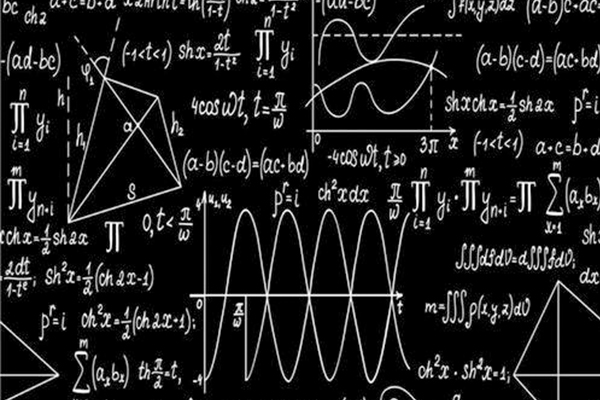IB资料
- ALEVEL
- 1
点击领取
同学们看了最近IBO官方发布的有关IB大考消息了吗?马上就是大考了,为了让大家对考点有一个更好的把握,我们给大家带来了一些改革后IB数学考纲介绍,以及一些常规问题的解答。

from patterns to generalizations: sequences and series模式和概括:序列和极数
1.1: Number patterns and sigma notation 数字模式和∑求和
1.2: Arithmetic and geometric sequences算数和几何序列
1.3: Arithmetic and geometric series算数和几何极数
1.4: Modelling using arithmetic and geometric series用算数和几何极数模型化
1.5: The binomial theorem 二项式定理
1.6: Proofs 证明题
Representing relationships: introducing functions表达关系:函数介绍
2.1: What is a function? 什么是函数?
2.2: Functional notation 函数符号
2.3: Drawing graphs of functions 函数的绘制
2.4: The domain and range of a function域值
2.5: Composition of functions组合函数
2.6: Inverse functions反函数
Modelling relationships: linear and quadratic functions关系模型化:线性函数和二次方函数
3.1: Parameters of a linear function线性函数的参数
3.2: Linear functions线性函数
3.3: Transformations of functions函数变化
3.4: Graphing quadratic functions二阶函数的绘制
3.5: Solving quadratic equations by factorization and completing the square因式分解和完全平方公式求根
3.6: The quadratic formula and the discriminant二阶公式的判别
3.7: Applications of quadratics二次方应用
Equivalent representations: rational functions等效呈现:有理数
4.1: The reciprocal function倒数函数
4.2: Transforming the reciprocal function反倒数函数
4.3: Rational functions of the form ax+b/cx+d ax+b/cx+d 有理函数的形式
Measuring change: differentiation测量变化:微分
5.1: Limits and convergence 极限和收敛
5.2: The derivative function导数函数
5.3: Differentiation rules微分法规则
5.4: Graphical interpretation of first and second derivatives第一和第二导数的图形解释
5.5: Application of differential calculus: optimization and kinematics微积分应用:最优化和运动学
Representing data: statistics for univariate data呈现数据:多因素方差统计
6.1: Sampling取样
6.2: Presentation of data数据呈现
6.3: Measures of central tendency集中趋势
6.4: Measures of dispersion离差测量
Modelling relationships between two data sets: statistics for bivariate data两套数据的关系模型化:双变量数据统计
7.1: Scatter diagrams点聚图
7.2: Measuring correlation测量相关性
7.3: The line of best fit 最佳拟合直线
7.4: Least squares regression最小平方回归法
Quantifying randomness: probability量化随机性:可能性
8.1: Theoretical and experimental probability理论和实验可能性
8.2: Representing probabilities: Venn diagrams and sample spaces表达可能性:韦恩图和样本空间
8.3: Independent and dependent events and conditional probability独立事件和相关事件,以及条件概率
8.4: Probability tree diagrams可能性树形图
Representing equivalent quantities: exponentials and logarithms呈现相等数量:指数曲线和对数
9.1: Exponents指数
9.2: Logarithms对数
9.3: Derivatives of exponential functions and the natural logarithmic function指数函数和导数和自然对数函数
From approximation to generalization: integration从近似值到归纳:积分
10.1: Antiderivatives and the indefinite integral反导数和不定积分
10.2: More on indefinite integrals不定积分更多内容
10.3: Area and definite integrals区间和定分
10.4: Fundamental theorem of calculus微积分基本定理
10.5: Area between two curves两个曲线之间的面积
Relationships in space: geometry and trigonometry in 2D and 3D空间关系:2D和3D中的几何学和三角学
11.1: The geometry of 3D shapes 3D图形几何学
11.2: Right-angles triangle trigonometry 直角几何学
11.3: The sine rule 正弦规则
11.4: The cosine rule 余弦规则
11.5: Applications of right and non-right angled trigonometry 直角三角和非直角三角的应用
Periodic relationships: trigonometric functions周期关系:三角函数
12.1: Radian measure, arcs, sectors and segments 弧度测量,弧,节面和弓形
12.2: Trigonometric ratios in the unit circle 单位圆中的三角比例
12.3: Trigonometric identities and equations 三角恒定式和方程式
12.4: Trigonometric functions 三角函数
Modelling change: more calculus关系模型化:微积分更多内容
13.1: Derivatives with sine and cosine正弦和余弦的导数
13.2: Applications of derivatives导数运用
13.3: Integration with sine, cosine and substitution正弦,余弦和取代法的解释
13.4: Kinematics and accumulating change运动学和累加变化
Valid comparisons and informed decisions: probability distributions有效比较和信息明确下的决策:可能性分布
14.1: Random variables随机变化
14.2: The binomial distribution二项式分布
14.3: The normal distribution 正态分布
From patterns to generalizations: sequences and series模式和概括:序列和极数
1.1: Sequences, series and sigma notation 序列,极数和∑求和
1.2: Arithmetic and geometric sequences and series 算数和几何序列和极数
1.3: Proof 证据
1.4: Counting principles and the binomial theorem 计算原则和二项式定理
Representing relationships: introducing functions表达关系:函数介绍
2.1: Functional relationships 函数关系
2.2: Special functions and their graphs 特殊函数和图像
2.3: Classification of functions 函数分类
2.4: Operations with functions函数运算
2.5: Function transformations函数转化
Expanding the number system: complex numbers扩展数字体系:复数
3.1: Quadratic equations and inequalities 二次方相等和不等
3.2: Complex numbers 复数
3.3: Polynomial equations and inequalities 多项式相等和不等
3.4: The fundamental theorem of algebra代数的基本理论
3.5: Solving equations and inequalities解决方程式和不等
3.6: Solving systems of linear equations线性方程式的解决体系
Measuring change: differentiation测量变化:微分
4.1: Limits, continuity and convergence极限,连续性和收敛
4.2: The derivative of a function 一个函数的导数
4.3: Differentiation rules微分法规则
4.4: Graphical interpretation of the derivatives 导数的图形解释
4.5: Applications of differential calculus 微积分应用
4.6: Implicit differentiation and related rates 隐微分法和相关比率
Analysing data and quantifying randomness: statistics and probability分析数据和量化随机性:统计和可能性
5.1: Sampling取样
5.2: Descriptive statistics描述统计学
5.3: The justification of statistical techniques统计技术的辩护
5.4: Correlation, causation and linear regression相关性,原因和线性回归
Relationships in space: geometry and trigonometry空间关系:几何学和三角学
6.1: The properties of 3D space 3D图形的属性
6.2: Angles of measure 角的测量
6.3: Ratios and identities 比率和相等
6.4: Trigonometric functions 三角函数
6.5: Trigonometric equations 三角相等
Generalizing relationships: exponents, logarithms and integration概括关系:指数幂,对数和积分
7.1: Integration as antidifferentiation and definite integrals 反导函数和定分的整合
7.2: Exponents and logarithms 幂和对数
7.3: Derivatives of exponential and logarithmic functions; tangents and normal指数和对数函数的导数;切线和常态
7.4: Integration techniques整合技巧
Modelling changes: more calculus变化模型化:微积分更多内容
8.1: Areas and volumes 面积与体积
8.2: Kinematics运动学
8.3: Ordinary differential equations (ODEs) 常规微方方程
8.4: Limits revisited函数极限再讨论
Modelling 3D space: vectors3D空间模型化:矢量
9.1: Geometrical representation of vectors矢量的几何学呈现
9.2: Introduction to vector algebra矢量代数介绍
9.3: Scalar product and its properties数积和它的属性
9.4: Vector equations of a line 一条直线的矢量方程式
9.5: Vector product and properties矢量积和属性
9.6: Vector equation of a plane平面的矢量方程式
9.7: Lines, planes and angles直线,平面和角
9.8: Application of vectors矢量的应用
Equivalent systems of representation: more complex numbers呈现的等效系统:复数更多内容
10.1: Forms of a complex number复数的组成
10.2: Operations with complex numbers in polar form极坐标形式中复数的操作
10.3: Powers and roots of complex numbers in polar form功率和极坐标形式中复数的根
Valid comparisons and informed decisions: probability distributions有效比较和信息明确下的决策:可能性分布
11.1: Axiomatic probability systems自明可能性系统
11.2: Probability distributions可能性分布
11.3: Continuous random variables连续随机变量
11.4: Binomial distribution二项式分布
11.5: The normal distribution正态分布Exploration
Measuring space: accuracy and geometry测量空间:精度和几何尺寸
1.1: Representing numbers exactly and approximately准确、近似地表示数字
1.2: Angles and triangles角度和三角形
1.3: three-dimensional geometry三维几何
Representing and describing data: descriptive statistics表示和描述数据:描述性统计
2.1: Collecting and organizing data收集和整理数据
2.2: Statistical measures统计测量方式
2.3: Ways in which we can present data展示数据的方式
2.4: Bivariate data二元数据
Dividing up space: coordinate geometry, lines, Voronoi diagrams, vectors划分空间:坐标几何,线,Voronoi图,向量
3.1: Coordinate geometry in 2 and 3 dimensions二维和三维坐标几何
3.2: The equation of a straight line in 2 dimensions二维直线方程
3.3: Voronoi diagrams Voronoi图
3.4: Displacement vectors位移向量
3.5: The scalar and vector product标量与向量的乘积
3.6: Vector equations of lines线的向量方程
Modelling constant rates of change: linear functions and regressions建模恒定变化率:线性函数和回归
4.1: Functions功能
4.2: Linear models线性模型
4.3: Inverse functions逆函数
4.4: Arithmetic sequences and series等差数列和级数
4.5: Linear regression线性回归
Quantifying uncertainty: probability量化不确定性:概率
5.1: Theoretical and experimental probability理论概率和实验概率
5.2: Representing combined probabilities with diagrams用图表表示组合概率
5.3: Representing combined probabilities with diagrams and formulae用图表和公式表示组合概率
5.4: Complete, concise and consistent representations完整、简洁、一致的表达
Modelling relationships with functions: power and polynomial functions与函数的建模关系:幂函数和多项式函数
6.1: Quadratic models二次模型
6.2: Quadratic modelling二次造型
6.3: Cubic functions and models三次函数与模型
6.4: Power functions, inverse variation and models幂函数、逆变分及模型
Modelling rates of change: exponential and logarithmic functions与函数的建模关系:幂函数和多项式函数
7.1: Geometric sequences and series几何序列和级数
7.2: Financial applications of geometric sequences and series几何序列和级数在金融中的运用
7.3: Exponential functions and models指数函数与模型
7.4: Laws of exponents - laws of logarithms指数和对数函数的运算法则
7.5: Logistic models对数模型
Modelling periodic phenomena: trigonometric functions and complex numbers周期现象建模:三角函数和复数
8.1: Measuring angles测量角度
8.2: Sinusoidal models: f(x) = asin(b(x-c))+d
正弦模型:f(x) = asin(b(x-c))+d
8.3: Completing our number system成我们的数字系统
8.4: A geometrical interpretation of complex numbers复数的几何解释
8.5: Using complex numbers to understand periodic models使用复数来理解周期模型
Modelling with matrices: storing and analyzing data用矩阵建模:存储和分析数据
9.1: Introduction to matrices and matrix operations矩阵和矩阵运算导论
9.2: Matrix multiplication and properties矩阵乘法及其性质
9.3: Solving systems of equations using matrices使用矩阵解方程组
9.4: Transformations of the plane平面的变换
9.5: Representing systems代表系统
9.6: Representing steady state systems表示稳态系统
9.7: Eigenvalues and eigenvectors特征值和特征向量
Analyzing rates of change: differential calculus变化率分析:微分学
10.1: Limits and derivatives极限和导数
10.2: Differentiation: further rules and techniques差异化:进一步的规则和技术
10.3: Applications and higher derivatives应用和更高阶导数
Approximating irregular spaces: integration and differential equations不规则空间近似:积分和微分方程
11.1: Finding approximate areas for irregular regions为不规则区域寻找近似区域
11.2: Indefinite integrals and techniques of integration不定积分与积分技巧
11.3: Applications of integration集成的应用
11.4: Differential equations微分方程
11.5: Slope fields and differential equations斜率场与微分方程
Modelling motion and change in 2D and 3D: vectors and differential equations建模二维和三维运动和变化:向量和微分方程
12.1: Vector quantities向量
12.2: Motion with variable velocity变速运动
12.3: Exact solutions of coupled differential equations耦合微分方程的精确解
12.4: Approximate solutions to coupled linear equation
建模二维和三维运动和变化:向量和微分方程
Representing multiple outcomes: random variables and probability distributions
呈现多个结果:随机变量和概率分布
13.1: Modelling random behaviour随机行为建模
13.2: Modelling the number of successes in a fixed number of trials固定数量的试验中成功数量的建模
13.3: Modelling the number of successes in a fixed interval固定的时间间隔内成功数量的建模
13.4: Modelling measurements that are distributed randomly随机分布的测量值建模
13.5: Mean and variance of transformed or combined random variables变换后或合并后随机变量的均值和方差
13.6: Distributions of combined random variables组合随机变量的分布
Testing for validity: Spearman's hypothesis testing and x2 test for independence有效性检验:斯皮尔曼假设检验和x2独立性检验
14.1: Spearman's rank correlation coefficient斯皮尔曼秩相关系数
14.2: Hypothesis testing for the binomial probability, the Poisson mean and the product moment correlation coefficient二项式概率、Poisson均值和乘积矩相关系数的假设检验
14.3: Testing for the mean of a normal distribution正态分布均值的检验
14.4: Chi-squared test for independence独立性的卡方检验
14.5: Chi-squared goodness-of-fit test卡方拟合优度检验
14.6: Choice, validity and interpretation of tests测试的选择、有效性和解释
Optimizing complex networks: graph theory优化复杂网络:图论
15.1: Constructing graphs构造图
15.2: Graph theory for unweighted graphs未加权图的图论
15.3: Graph theory for weighted graphs: the minimum spanning tree加权图的图论:最小生成树
15.4: Graph theory for weighted graphs - the Chinese postman problem加权图的图论——中国邮差问题
15.5: Graph theory for weighted graphs - the travelling salesman problem加权图的图论——旅行商问题

Measuring space: accuracy and 2D geometry测量空间:精度和二维几何
1.1: Measurements and estimates测量和估计
1.2: Recording measurements, significant digits and rounding记录测量值、有效位数和舍入
1.3: Measurements: exact or approximate?测量:精确还是近似?
1.4: Speaking scientifically讲科学
1.5: Trigonometry of right-angled triangles and indirect measurements直角三角形三角学和间接测量
1.6: Angles of elevation and depression升降角度
Representing space: non-right angled trigonometry and volumes呈现空间:非直角三角形和体积
2.1: Trigonometry of non-right triangles非直角三角形的三角学
2.2: Area of triangle formula. Applications of right and non-right angled trigonometry非直角三角形的三角学
2.3: Geometry: solids, surface area and volume几何:固体、表面积和体积
Representing and describing data: descriptive statistics表示和描述数据:描述性统计
3.1: Collecting and organising univariate data收集和组织单变量数据
3.2: Sampling techniques抽样技术
3.3: Presentation of data数据的表示
3.4: Bivariate data二元数据
Dividing up space: coordinate geometry, lines, Voronoi diagrams划分空间:坐标几何,线条,Voronoi图
4.1: Coordinates, distance and midpoint formula in 2D and 3D线的梯度及其应用
4.2: Gradient of lines and its applications线的梯度及其应用
4.3: Equations of straight lines; different forms of equations直线方程;方程的不同形式
4.4: Parallel and perpendicular lines平行线和垂直线
4.5: Voronoi diagrams and toxic waste problemVoronoi图与有毒废物问题
Modelling constant rates of change: linear functions建模恒定变化率:线性函数
5.1: Functions功能
5.2: Linear Models线性模型
5.3: Arithmetic Sequences算术序列
5.4: Modelling造型
Modelling relationships: linear correlation of bivariate data建模关系:双变量数据的线性相关
6.1: Measuring correlation测量相关
6.2: The line of best fit最佳配合线
6.3: Interpreting the regression line解释回归曲线
Quantifying uncertainty: probability, binomial and normal distributions量化不确定性:概率、二项分布和正态分布
7.1: Theoretical and experimental probability理论概率和实验概率
7.2: Representing combined probabilities with diagrams用图表表示组合概率
7.3: Representing combined probabilities with diagrams and formulae用图表和公式表示组合概率
7.4: Complete, concise and consistent representations完整、简洁、一致的陈述
7.5: Modelling random behaviour: random variables and probability distributions对随机行为建模:随机变量和概率分布
7.6: Modelling the number of successes in a fixed number of trials在固定数量的试验中建立成功数量的模型
7.7: Modelling measurements that are distributed randomly随机分布的建模测量值
Testing for validity: Spearman's, hypothesis testing and x2 test for independence效度检验:斯皮尔曼检验、假设检验和x2独立性检验
8.1: Spearman's rank correlation coefficient斯皮尔曼秩相关系数
8.2: chi2 test for independence
chi2独立性检验
8.3: chi2 goodness of fit test
chi2拟合优度检验
8.4: The t-test检验
Modelling relationships with functions: power functions与函数的建模关系:幂函数
9.1: Quadratic models二次模型
9.2: Problems involving quadratics二次方程问题
9.3: Cubic models, power functions and direct and inverse variation三次模型、幂函数和正变分与逆变分
9.4: Optimisation优化
Modelling rates of change: exponential and logarithmic functions变化率的建模:指数函数和对数函数
10.1: Geometric sequences and series几何序列与级数
10.2: Compound interest, annuities, amortization复利、年金、摊销
10.3: Exponential models指数模型
10.4: Exponential equations and logarithms指数方程和对数
Modelling periodic phenomena: trigonometric functions周期现象建模:三角函数
11.1: An introduction to periodic functions周期函数简介
11.2: An infinity of sinusoidal functions周期函数简介
11.3: A world of sinusoidal models正弦模型的世界
Analyzing rates of change: differential calculus变化率分析:微分学
12.1: Limits and derivatives极限和导数
12.2: Equation of tangent and normal and increasing and decreasing functions正切函数、法向函数、递增函数、递减函数方程
12.3: Maximum and minimum points and optimization最大和最小点和优化
Approximating irregular spaces: integration近似不规则空间:整合
13.1: Finding areas发现领域
13.2: Integration: the reverse processes of differentiation积分:分化的逆向过程
HL课程有选修内容吗?
目前的数学HL课程的数学内容除了核心课程以外,学员还需要从4个选修内容(概率与统计,集合,关系与群论,微积分,离散数学)中选择一个选修。
在新的课程中,原有的4个选修部分被取消,Mathematics: Analysis and approaches(HL)中加入了统计和高数相关内容,而Mathematics: Applications and interpretation(HL)则会涉及统计和离散相关内容。
想在大学学习数学专业的学员应该选择哪门课程?
学员如果想要修读涉及大量数学内容的大学课程,那么应该选择Mathematics: Analysis and approaches。那些想要学习社会科学、人文科学、某些经济学、统计学和某些工程学课程以及艺术的学员可以选择Mathematics: Applications and interpretation。
有关IB数学的考试大纲分享就到这里。如果你是目标牛剑G5的IB学员,那么就要往42-44这个分数段去努力了,但往往决定IB分数分界线的就是IA和以IA为代表的学术英语写作能力。如果你想接受这方面的专项训练,或者进阶自己其他科目的成绩,点击预约试听【橡沐IB同步培训班】——

点击
IB改革后IB数学选课选错会被目标大学拒绝?附G5院校对于IB数学选课要求
查看。
